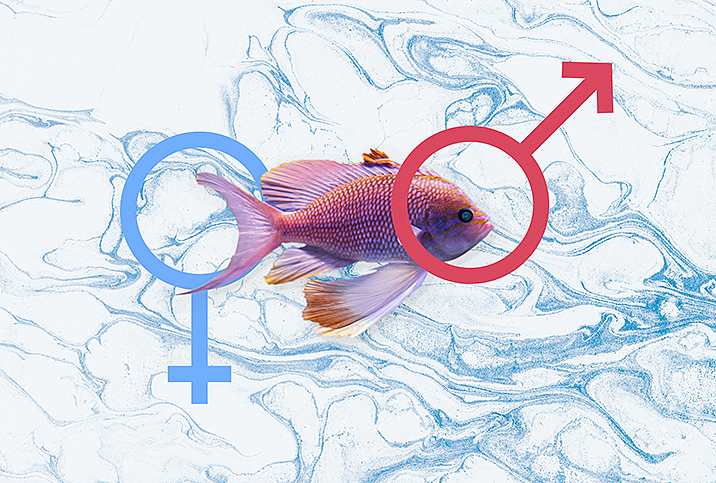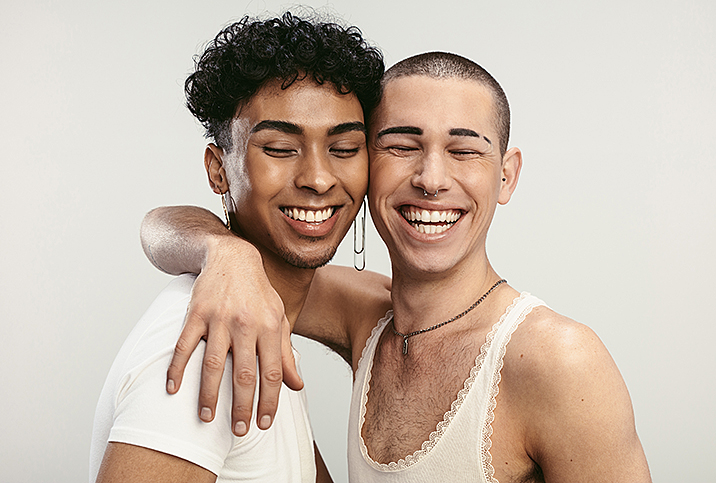Here’s What Gives Trans People Gender Euphoria in the Bedroom

After a romantic, drunken date a few years ago, 24-year-old Jordan, a trans OnlyFans creator based in the U.K., worked up the confidence to sleep with his then-boyfriend, also a trans guy, for the first time.
“We were both in the early stages of transition––pre-surgery and pre-testosterone,” he explained. “There was just something in the way we were holding each other that made me feel like something had clicked like we were two guys doing this, and this was how it should be.”
This warm glow of affirmation was Jordan’s first experience of a feeling known in trans and gender non-conforming communities as “gender euphoria.” If you’re looking for a formal definition of this phenomenon, you won’t find it.
In a nutshell, it’s the positive counterpart to gender dysphoria, defined as a feeling of intense psychological distress triggered by an internal disconnect with the gender you’re assigned at birth. Not all trans people experience dysphoria, but because trans bodies are so heavily medicalized, access to hormones and life-saving surgeries is often dependent on a diagnosis.
The joyous validation of “gender euphoria” remains under-discussed––especially when it comes to activities in the bedroom. Trans photographers and writers have sketched out loose definitions, describing it as an overwhelming sense of affirmation. This can come from correct pronoun usage, autonomy over your aesthetic or even a compliment from a stranger––basically, anything that assures you that people are seeing you the way you see yourself.
When it comes to sex, things are a little different. Juno Roche, a 57-year-old, non-binary author who uses they/them pronouns, has spent years filling these gaps in horny histories, most notably in the candid, interview-led book "Queer Sex."
Roche writes honestly about the euphoria they found in exploring, pleasuring and finding new names for their genitals after gender confirmation surgery (“I describe them as an up-cycled cock and balls that really look like a vagina, and I think that’s magical”), but they also write intimate accounts of other queer sex lives.
In Roche’s experience, communication is the key to gender euphoria. “The people that were having really great, euphoric sex would talk about their trans bodies in a way that was really sexy, and there’s something electrifying about that,” they explained, citing one interviewee who talked about their “bottom growth” on testosterone.
There are some exceptions, but mainstream society often treats trans bodies as curiosities or subjects of debate, dissecting their existence in order to police them through discriminatory legislation. The horny explorers in Juno’s book had worked to understand and then embrace their bodies despite this stigma, discussing their turn-ons, kinks and erogenous zones in detail, both before and during sex.
“Having those conversations allows you to be fully present in those moments,” Juno explained. “Nothing is worse for an orgasm than tension or anxiety around your body.”
Working through dysphoria––either with a partner or solo––to figure out what truly feels good can be a breakthrough, but it requires self-exploration and clear communication.
Sade, a non-binary, 24-year-old sex worker based in the U.K., grew frustrated by shitty hookups who either misgendered them (“I’m constantly called a woman by partners”) or projected their stereotypes of trans people while simultaneously ignoring Sade’s desires.
“I get fetishized in nearly every message I receive,” they explained. “Whether it’s ignoring the fact I’m a dom, calling me horrible names in an attempt to be sexy or just not understanding trans people and reducing us to fantasies, it’s been a lot to deal with.”
As a result, Sade usually ended up having to educate these kinky prospective partners––”that’s not exactly what you’re looking for when you’re just trying to get dick,” they laughed.
Now, Sade slows things down: “When someone really takes the time to get to know what you like before diving in deep, that starts to feel really euphoric for me.”
It can be as simple as asking what to do with your hands, mouth or genitals and suggesting new kinks before working through what they would look like in terms of boundaries.
“It’s also about body language and how someone is choosing to care for you, both in and out of sexy time,” they continued.
In other words, the euphoria doesn’t have to end post-orgasm. Continued affection and intimacy can prolong this sense of affirmation long after the sheets have dried.
It’s not always the case, but T4T (trans-for-trans) relationships tend to center these discussions early on, increasing the chance of a sexy, euphoric experience. The cultural prevalence of transphobia can make disclosing trans identities to cisgender partners feel daunting, as proven by the stigma around trans dating and the existence of “trans panic” laws, which can lessen homicide sentences if the victim is trans.
T4T relationships can bypass plenty of this initial stress, which in turn can make sexual communication easier.
“With trans guys, I can openly say, ‘Do this, touch me there and do that,’ without even thinking about it,” Jordan said.
He also explained that “when you start hormones, your desires change,” but dysphoria can still make some sexual scenarios feel daunting. Jordan gives the example of oral sex, which can be a trigger for some transgender people. With clear communication and a base level of trust, he found he could relax into the experience. Or, as he jokingly summarized: “I used to hate people going down on me, but now I’m like, 'Yeah, you can do that every day!'”
Listening to cues is important, too. 24-year-old non-binary Magic explained that they “frequently deal with sex repulsion because when people find out I have a pussy, they think it’s okay to treat me like a woman.” Euphoria comes when a partner acknowledges their fluidity and adjusts their dirty talk accordingly.
“I had been flirting with someone for a while online, and at one point I posted that, when I’m masculine, I’m a pretty little boy that wants to be kicked and stepped on.” Their kinky conquest saw the post and responded accordingly: “His response was something along the lines of, 'I’m down to kick some pretty boys.'”
Because trans bodies differ wildly––some people opt for hormones and surgeries, others don’t––there is no blueprint for gender euphoria, and it’s important to acknowledge that not everyone will feel comfortable enough to open up about their desires. Dysphoria in the bedroom can rear its head at any time, so regular check-ins, such as asking partners “How is that for you?” are necessary markers of intimacy.
Working through dysphoria––either with a partner or solo––to figure out what truly feels good can be a breakthrough, but it requires self-exploration and clear communication.
“I’ve always said that trans bodies are exciting because they’re reshaping and refashioning to gain much more pleasure,” Roche said. “I remember interviewing someone, and they said, 'I always realized that I wanted to fuck someone but not with my own dick, with a strap-on.' You have to be really at peace with yourself to be able to say those things with such panache, laughter and joy.”
For Jordan, gender euphoria in the bedroom is ultimately “a feeling of power and control,” and he emphasized that listening to trans partners is the key to this pure, horny joy. “Some people might want to keep their clothes on to alleviate dysphoria, whereas I’m basically comfortable walking around in a jockstrap,” he laughed.
Although trans bodies aren’t inherently political (just relentlessly politicized), Jordan underlined the importance of understanding and communicating his turn-ons.
“The world takes a lot of ownership away from trans people,” he concluded. “If you look at debates around trans health care and puberty blockers, there’s this consensus that we’re incapable of making our own decisions. Gender euphoria is ultimately about taking control over our bodies in a world which tries to deny us that right.”


















